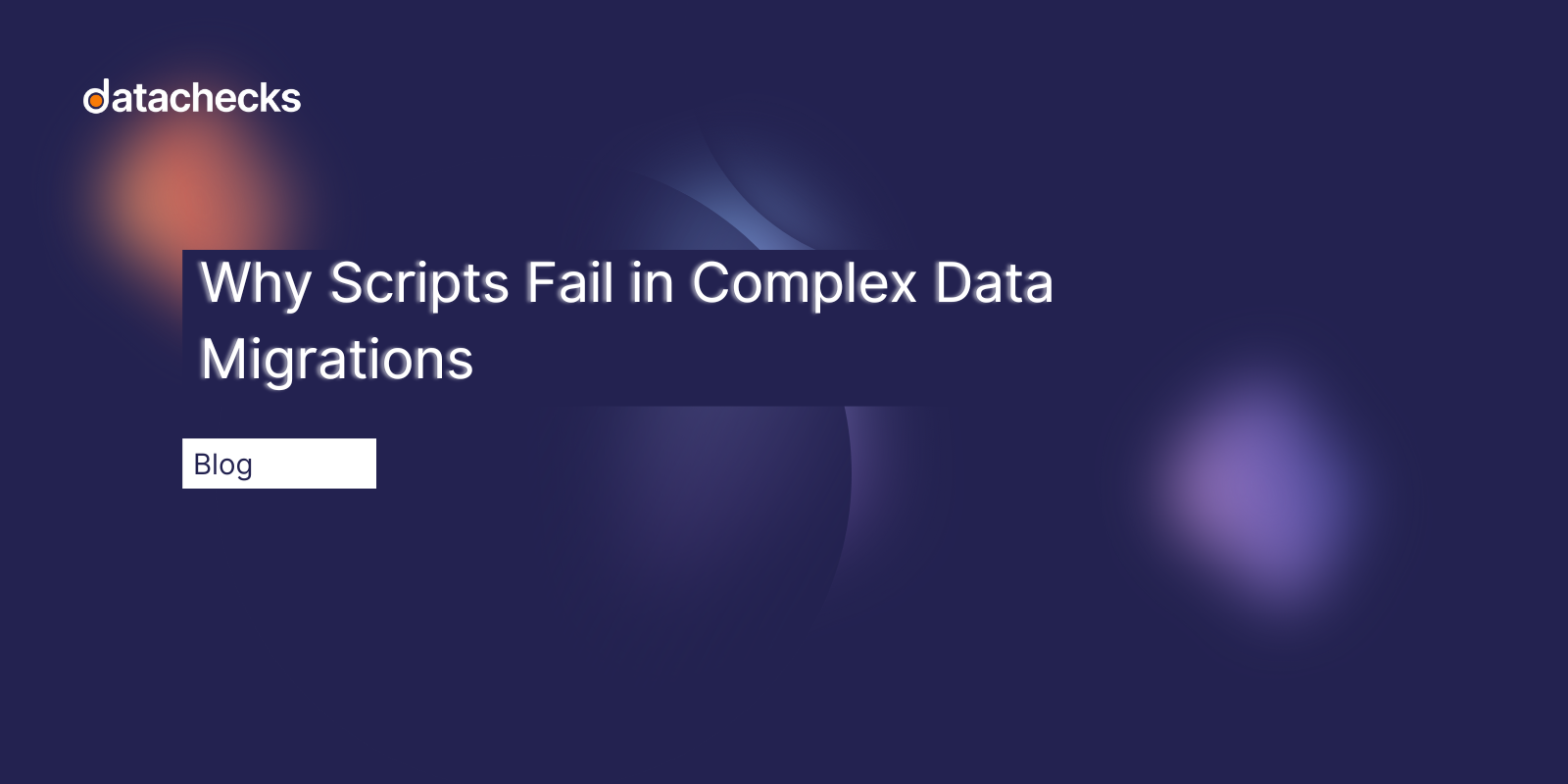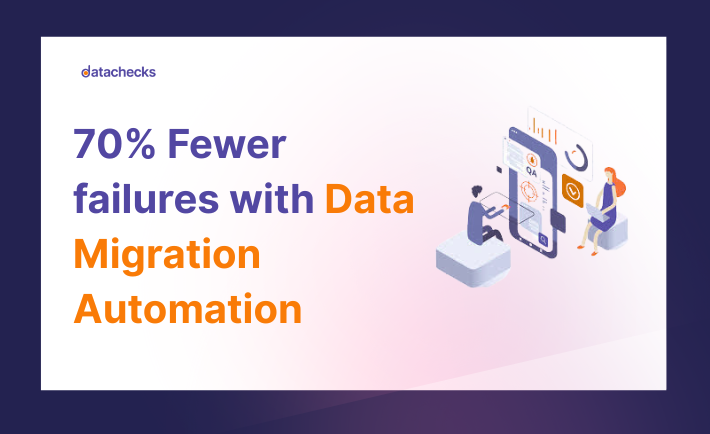The sobering reality of data migration projects continues to challenge enterprises worldwide. With over 80% of data migration projects failing to meet goals or going over budgets, and 62% of migration failures stemming from errors in custom coding or insufficient testing, it's clear that traditional script-based approaches are fundamentally inadequate for today's complex data environments.
Why Custom Scripts Crumble Under Pressure
Traditional data migration scripts, while seemingly cost-effective and straightforward, carry inherent limitations that become magnified in complex enterprise environments. These hand-coded solutions typically operate under the assumption of static data structures and predictable volumes—assumptions that rarely hold true in real-world scenarios.
The core vulnerabilities of script-based migrations include:
Lack of Adaptive Intelligence: Custom scripts are rigid by design. When data structures change mid-project—a common occurrence in dynamic business environments—scripts require manual intervention and recoding. This rigidity becomes particularly problematic when dealing with legacy systems that may have undocumented data relationships or inconsistent formatting patterns.
Limited Error Handling and Recovery: Hand-coded scripts typically lack features like automated data profiling, lineage tracking, error handling, or rollback mechanisms, which are critical for enterprise-grade migrations. When errors occur—and they inevitably do—scripts often fail catastrophically rather than gracefully handling exceptions or providing clear diagnostic information.
Scalability Constraints: Scripts that work perfectly with test datasets often break down when confronted with production-scale data volumes. Memory limitations, processing timeouts, and resource contention issues emerge as data volumes grow beyond initial expectations.
Documentation and Maintenance Burden: Custom scripts become increasingly difficult to maintain, especially when original developers leave the organization or when business requirements evolve. The absence of comprehensive documentation compounds this challenge, creating knowledge silos that increase project risk.

Modern Data Migration Challenges
Today's data migration landscape presents unprecedented complexity that exponentially increases the likelihood of script failure:
Multi-Cloud and Hybrid Architectures: Organizations now operate across multiple cloud platforms and maintain hybrid on-premises-cloud environments. Scripts must navigate different APIs, security protocols, and data formats across these diverse ecosystems.
Real-Time Data Synchronization: Modern businesses require near-zero downtime migrations, demanding sophisticated synchronization mechanisms that maintain data consistency while systems remain operational.
Regulatory Compliance and Data Governance: Issues such as inconsistent, duplicate, or outdated data can compromise the functionality of the new system and undermine the reliability of analytics. Compliance requirements demand comprehensive audit trails, data lineage tracking, and validation processes that simple scripts cannot provide.
Data Volume and Velocity: The exponential growth in data volumes, combined with the need for faster migration cycles, pushes traditional scripting approaches beyond their breaking point.
The Agentic AI Revolution
Enter agentic AI—a paradigm shift that promises to revolutionize how we approach data migration quality assurance. Agentic AI describes autonomous machine "agents" that move beyond query-and-response generative chatbots to do enterprise-related tasks without human guidance.
Unlike traditional scripts, agentic AI systems bring intelligence, adaptability, and autonomous decision-making capabilities to data migration processes. These AI agents can:
Intelligently Adapt to Changing Conditions: Agentic AI systems can recognize when data structures or business rules change and automatically adjust their approach without human intervention. They can learn from patterns in the data and make intelligent decisions about how to handle edge cases or unexpected scenarios.
Comprehensive Quality Assurance: In 2025, QA isn't just about running tests—it's about ensuring user experience, performance, and agility. Agentic AI tools can perform continuous validation, monitoring data quality throughout the migration process and flagging potential issues before they become critical problems.
Autonomous Problem Resolution: When errors occur, agentic AI systems can often resolve them automatically by drawing on their training data and learned patterns. They can implement rollback procedures, retry failed operations with modified parameters, or route complex issues to human operators with detailed diagnostic information.
Predictive Risk Assessment: AI agents can analyze migration patterns and historical data to predict potential failure points, enabling proactive risk mitigation rather than reactive problem-solving.
Implementation Strategies for Agentic Data Migration QA
Organizations looking to leverage agentic AI for data migration QA should consider a phased approach:
Phase 1: Monitoring and Validation Agents
Deploy AI agents focused on continuous data quality monitoring and validation. These agents can run alongside existing migration processes, learning patterns and building confidence in their capabilities before taking on more autonomous roles.
Phase 2: Intelligent Error Handling
Implement agents capable of autonomous error detection and resolution for common migration issues. These systems can handle routine problems while escalating complex scenarios to human operators.
Phase 3: Autonomous Migration Management
Advanced implementations can include agents capable of planning, executing, and monitoring entire migration workflows with minimal human oversight.
Navigating the Implementation Challenges
While agentic AI presents compelling opportunities, organizations must navigate several implementation challenges. Over 40% of agentic AI projects will be canceled by the end of 2027, due to escalating costs, unclear business value or inadequate risk controls.
Success requires:
Clear ROI Definition: Organizations must establish measurable success criteria and expected returns before implementation begins.
Adequate Risk Controls: Implementing appropriate governance frameworks to ensure AI agents operate within acceptable parameters.
Gradual Integration: Rather than wholesale replacement of existing processes, successful implementations typically involve gradual integration and capability building.
Change Management: Preparing teams for the shift from script-based to AI-driven migration processes requires comprehensive training and cultural change management.
The Future of Data Migration
Agentic AI will revolutionize quality engineering just as automation did ten years ago. With the marriage of autonomy and AI-based insights, testing can be accelerated, more comprehensive, and more affordable.
The transformation from script-based to AI-driven data migration represents more than a technological upgrade—it's a fundamental shift toward intelligent, adaptive systems that can handle the complexity and scale of modern enterprise data environments.
Organizations that recognize this shift and begin implementing agentic AI solutions for data migration QA will find themselves better positioned to handle future migrations with greater confidence, lower risk, and higher success rates. The question isn't whether agentic AI will transform data migration—it's whether your organization will be ready to harness its potential.
As we move into 2025 and beyond, the combination of increasing data complexity and advancing AI capabilities makes this transition not just beneficial, but essential for organizations serious about migration success. The era of fragile, script-dependent migrations is ending, replaced by intelligent, adaptive systems capable of handling whatever challenges tomorrow's data landscape may bring.



.svg)







